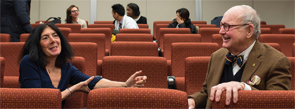
Division Director Jill P. Buyon, MD, left, and Professor Emeritus and former Division Director Gerald Weissmann, MD, right, speak at a Rheumatology Grand Rounds at NYU Langone.
From its beginnings as the Rheumatic Diseases Study Group (RDSG) in the early 1930s, NYU Langone Medical Center’s Division of Rheumatology has been built on a tradition of research and clinical care. Today’s division, with 24 full-time and 76 part-time faculty members, continues to push toward understanding the pathogenesis of rheumatic diseases and interventions to improve outcomes.
For example, in addition to her National Institutes of Health (NIH) supported lupus laboratory and studies on neonatal lupus, Division Director Jill P. Buyon, MD, the Lady Va and Sir Deryck Maughan Professor of Rheumatology, recently published the results of a multi-center study of the risks of pregnancy in mothers with lupus. In another laboratory, José U. Scher, MD, assistant professor, Department of Medicine, and colleagues explore the connection between the microbiome and psoriatic arthritis.
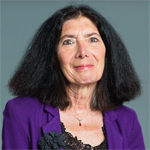
Jill P. Buyon, MD,
Division Director
At the seven affiliated outpatient hospitals, ranging from Bellevue Hospital to the Manhattan VA to NYU Langone’s Tisch Hospital and Hospital for Joint Diseases, clinicians and trainees encounter diverse patient populations that contribute to the depth of research for understanding the early diagnosis and treatment of rheumatic conditions.
A tradition of basic science exploration, married to the diversity of patient populations, defines NYU Langone’s Division of Rheumatology as a top U.S. division, notes Gerald Weissmann, MD, professor emeritus of medicine, past president of ACR, who was director of the division from 1973 to 2000.
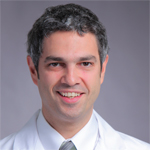
José U. Scher, MD,
Assistant Professor, Department of Medicine
It was this combination that drew Gregg Silverman, MD, professor, Department of Medicine and Department of Pathology, to move from his former post as a professor at the University of California, San Diego and an adjunct member of the Department of Molecular and Experimental Medicine at The Scripps Research Institute in La Jolla. “NYU Langone has the most remarkable clinical facilities and we provide the highest standard of clinical care,” Dr. Silverman remarks. “There can be no better place for studying lupus and related autoimmune diseases than New York City.”
Training & Retaining Talent
The Division’s longstanding training program, established as a formal ACGME (Accreditation Council for Graduate Medical Education) program in 1986 by Steven B. Abramson, MD, who later became division director, currently includes eight fellows. Dr. Abramson is now the Frederick H. King Professor of Internal Medicine and chair, Department of Medicine, and vice dean for education faculty & academic affairs at NYU Langone.
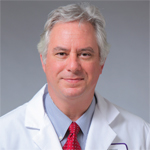
Gregg Silverman, MD, Professor, Department of Medicine and Department of Pathology
From Dr. Weissmann’s time forward, many who trained with the Division went on to join the faculty and become leaders. H. Michael Belmont, MD, professor, Department of Medicine, associate director of clinical affairs in the Division of Rheumatology and medical director of the Hospital for Joint Diseases arrived at NYU Langone in 1983 for a two-year fellowship. “When I met Dr. Weissmann,” Dr. Belmont recalls, “I was very impressed with his general world knowledge, his extraordinary familiarity with rheumatic disease, and brilliance when it came to the inflammatory response.”
In addition, the opportunity to practice at such hospitals as [then-called] University Hospital and Bellevue, “where diseases are often present either in their most unvarnished fashion or at their most intense,” all factored into Dr. Belmont’s choice. During his second and research fellowship year, he served as chief fellow and has remained in the division since that time. His early studies on complement activation and clumping of neutrophils in collaboration with Dr. Abramson would prove to be highly relevant to the pathogenesis of lupus.
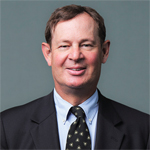
H. Michael Belmont, MD, Professor, Department of Medicine
As a resident at Albert Einstein College of Medicine, Michael Pillinger, MD, was “always aware” of the Division’s reputation, not only for its breadth of scientific innovation but its tradition of literary scholarship (Pulitzer Prize winner Lewis Thomas’ The Lives of a Cell as a case in point). Now, as director of the Rheumatology Fellowship Program, Dr. Pillinger employs the principles he learned as a fellow in the Division.
“I learned not to talk about disease without talking about the latest research, especially the pathophysiology,” Dr. Pillinger recalls. “There’s reasoning by evidence-based medicine, but in rheumatology, we have always reasoned by pathophysiology. When my fellows examine a joint, I really want them to imagine the cellular processes that are happening between their fingers.” Mentoring fellows and involving them in his research (currently focused on comorbidities and gout) says Dr. Pillinger, gives him tremendous satisfaction. He fulfills additional roles as professor, Department of Medicine and Department of Biochemistry and Molecular Pharmacology and director of rheumatology at the Manhattan VA.
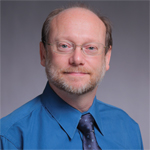
Michael Pillinger, MD,
Director of the Rheumatology Fellowship Program
Conferences are a key feature of the fellowship program. In a typical week, says Dr. Pillinger, there will be at least one a day. Faculty members come and go, circulating through the various hospitals. The cross-fertilization regarding research is a natural result of traversing the “super block” of affiliated NYU Langone hospitals in Manhattan.
Dr. Silverman, nationally recognized for his work on B cells and the immunopathogenesis in RA, lupus and a range of autoimmune and infectious disease, funded by NIH and the Rheumatology Research Foundation among other bodies, plays a prominent role in the Division’s seminars relating to the basic sciences and translational research. He also teaches medical students and graduate students on topics in the basic sciences and clinical medicine.
In addition to his clinical and translational research, Dr. Belmont’s role as an educator includes preparing fellows in the diagnosis and management of systemic connective tissue diseases, chiefly lupus, but also scleroderma, dermatomyositis and antiphospholipid syndrome. He also presents at the annual “research speed-dating session,” a special day when faculty members involved in translational research describe for fellows their ongoing projects. “It’s a chance for each of us to learn and get status reports on our faculty members’ laboratory findings and future directions,” he says.
Registry Advances Research
Dr. Buyon, who trained with Dr. Weissmann, and whose research focuses on bench to bedside studies in lupus and anti-Ro associated congenital heart block, assumed the position of Division Director in 2013 when Dr. Abramson became chair of the Department of Medicine. Her laboratory in the Medical Science Building of Tisch Hospital has become “action central” for the activities of the Division.
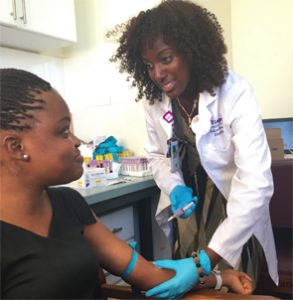
Ashira Blazer, MD, with a patient
at a clinic in Ghana, where she
researches SLE.
Establishment of the Division-wide patient registry, named the Specimen and Matched Phenotype Linked Evaluation, or SAMPLE, has boosted the mission to integrate patient care with basic science research, she says. A joint effort by members of the faculty and expanding upon studies previously initiated by Drs. Silverman, Scher and Abramson, the protocol was approved by the Institutional Review Board to use a uniform consent for collecting blood and tissue samples from all patients with autoimmune disease. The consent forms are written in English, Spanish and Mandarin, reflecting the population NYU serves. The biorepository linking clinical information and specimens is maintained by Robert Clancy, PhD, associate professor of medicine. “This has become a wonderful resource for NYU Langone,” says Dr. Silverman, who is spearheading research on the microbiome in lupus.
Dr. Belmont agrees. “By creating this bioregistry, we are in a position to very accurately describe specific subsets of patients with heterogeneous conditions such as SLE, and the biomarkers that allow identification of early disease and response to treatment. We are then in the best position for others at the bench [Drs. Silverman, Clancy, Mor and Nowatzky] to find the next opportunity for treatment.”
Jonathan Samuels, MD, an associate professor and clinical researcher focusing on osteoarthritis of the hands and knees, has also been enrolling his patients in the SAMPLE biorepository. In addition to his practice at the NYU Langone’s Center for Musculoskeletal Care, he also spends time teaching at the Manhattan VA and Bellevue sites. Now branching off into clinical research using musculoskeletal ultrasound, and studying the impact of bariatric surgery on osteoarthritis, Dr. Samuels credits the tone set by Director Buyon and his initial recruitment by Dr. Abramson for fostering his own ongoing opportunities within the Division.
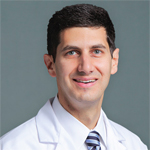
Jonathan Samuels, MD, Associate Professor, Department of Medicine
Dr. Abramson maintains an active research laboratory focused on osteoarthritis in partnership with Mukundan Attur, PhD, assistant professor of medicine. “We have the resources to do wonderful things, and a welcoming environment to make those happen,” Dr. Samuels says.
Probing Ethnic Disparities in Lupus
The Division’s reputation and opportunities to do clinical and basic science are obviously very attractive. Still, “It took a very special program to bring me here,” says Ashira Blazer, MD, instructor of medicine. Having trained in Texas and Tennessee, Dr. Blazer had been focused on lupus, mostly in a clinical setting, but the fellowship program at NYU Langone offered the opportunity to work with Drs. Buyon and Clancy to add research to her skillset. Recipient of a 2015 Rheumatology Research Foundation Scientist Development Award, Dr. Blazer has focused her research on racial and ethnic disparities in lupus and is adding to the knowledge base through her current collaboration with West African researchers to collect primary data and samples from Ghanaian patients, and to compare those with data in NYU Langone’s SAMPLE biorepository.
In the U.S., Dr. Blazer points out, “African American ethnicity is almost seen as a surrogate for socioeconomic status.” From that notion springs the belief that lower socioeconomic status is the principal driver of outcomes in African Americans with lupus. These conceptions (or misconceptions), she asserts, do not capture the true reasons behind disparate outcomes and draw attention away from potential biologic or genetic causes. “Having the opportunity to look at true biologically determined differences is a great one,” she notes. “This [working at NYU Langone] is the culmination of everything I’ve worked for.”
On the home front, Peter Izmirly, MD, assistant professor of medicine, continues NYU’s attention to minority health through his recent leadership of a major Centers for Disease Control and Prevention (CDC) project to study the epidemiology of lupus in Asians and Hispanics.
Hospital at the Core
It was Lewis Thomas who believed that “real science should be done on the same floor and by the same people who are treating patients,” says Dr. Weissmann. The co-location of research labs at Bellevue Hospital [now officially known as NYC Health + Hospitals/Bellevue] became “the center of what has made NYU Langone rheumatology spectacular,” he points out.
Dr. Pillinger agrees that Bellevue, the oldest U.S. public hospital [established in 1736], where the underserved make up 80% of the patient population, is “really quite special.” Trainees rotate through Bellevue monthly, encountering patients from over 50 different countries of origin, where treatment is available to everyone—from an Ebola patient arriving at Kennedy Airport to a cab driver needing a quadruple bypass.
Dr. Weissmann says that Bellevue Hospital, what he calls “one of the treasures of American medicine,” has contributed to the uniqueness of the Division.
Research Opportunities Abound
“At NYU Langone, we have an incredible opportunity to take on research,” says Dr. Scher. Thirteen years ago, he arrived as a trainee in the division, originally focused on rheumatic diseases. Success with biologics in both rheumatic conditions and psoriatic disease piqued his interest, especially the fact that patients with psoriatic disease responded specifically to IL-17 and IL-23 blockade. Dr. Scher was interested in other immunological approaches to this often understudied disease, and was encouraged by his mentor, Dr. Abramson, to build on his expertise with the microbiome. Dr. Scher now heads the medical center’s Psoriatic Arthritis Center. The collaborative explorations, in which dermatologists as well as rheumatologists, pathologists and others, seek further microbial targets to intercept disease processes, are funded in part by NIH and philanthropic grants such as those from the Riley Family Foundation and the Beatrice Snyder Foundation.
Legacy of Scientific Inquiry
“What I try to instill in my fellows and my patients is that we need to be able to truly understand disease processes before we even prescribe any medication. That has been the legacy of many others before me,” says Dr. Scher.
That legacy can be traced to 1932 when the dean of the NYU School of Medicine, O. Currier McEwen, MD, founded the RDSG. Dr. McEwen and Joseph Bunim, MD, who later became director of the NIH clinical center, were responsible for seminal work on cortisone and rheumatic fever. Dr. Weissmann’s father, a rheumatologist at Mt. Sinai, took his son to a talk by Drs. McEwan and Bunim in 1950. Thus, “It was cortisone that brought me to rheumatology,” Dr. Weissmann notes.
After 36 years, Edward Franklin, MD, succeeded Dr. McEwen as director of the RDSG. The noted NYU cell biologist and essayist Lewis Thomas, then dean of the School of Medicine, appointed Dr. Weissmann as director of a novel Division of Cell Biology in 1963, and in 1973 Saul Farber appointed him head of the newly reorganized Division of Rheumatology in the Department of Medicine.
During his tenure as chair of the division, Dr. Weissmann continued his own research and, along with colleagues, such as Leslie Vosshall now at the Rockefeller Institute and Charles Serhan, now at the Harvard Medical School, spent summers at the Marine Biology Laboratory (MBL) Woods Hole Oceanographic Institute in Massachusetts. In July 2015, on his 85th birthday, Dr. Weissmann was recognized for his work and named an MBL Legend.
“The unifying factor of all the research [at the Division] was the molecular biology of inflammation and its associated immune response,” he notes. That foundation forms the core of the Division’s work today.
Gretchen Henkel is a medical journalist based in California.


